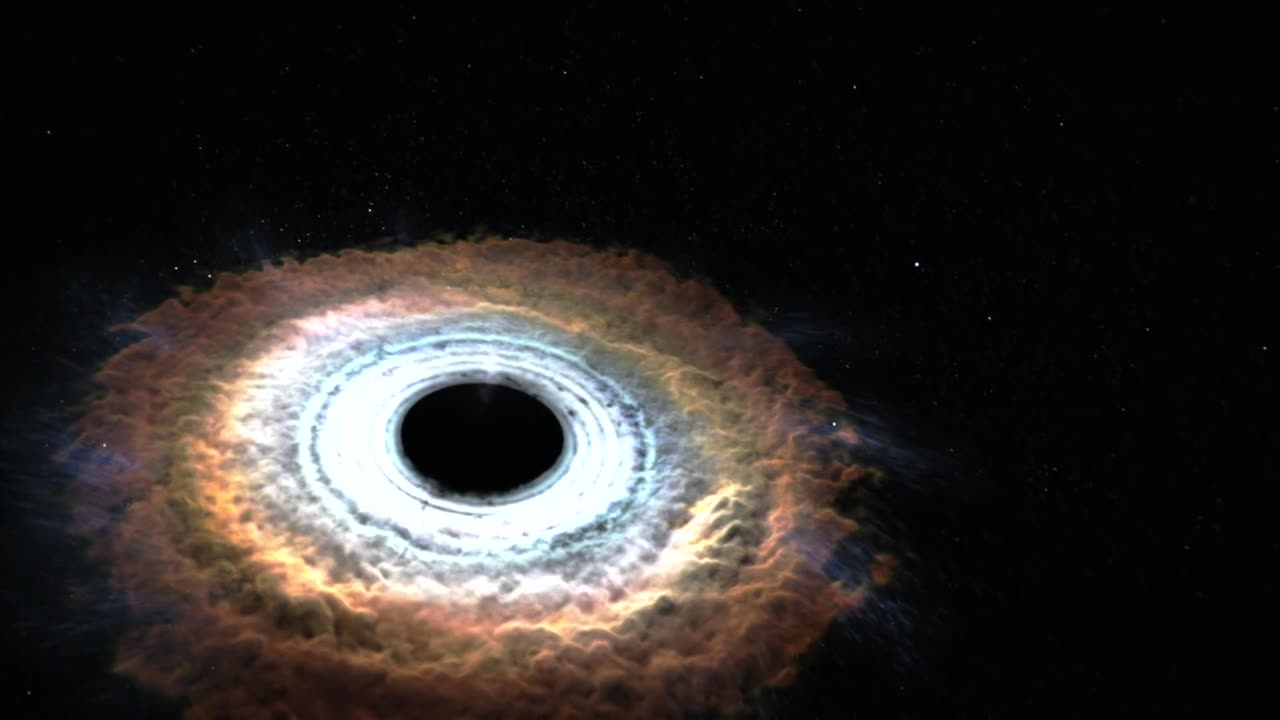Premium Only Content

NASA | Massive Black Hole Shreds Passing Star
Description
NASA Goddard
This artist’s rendering illustrates new findings about a star shredded by a black hole. When a star wanders too close to a black hole, intense tidal forces rip the star apart. In these events, called “tidal disruptions,” some of the stellar debris is flung outward at high speed while the rest falls toward the black hole. This causes a distinct X-ray flare that can last for a few years. NASA’s Chandra X-ray Observatory, Swift Gamma-ray Burst Explorer, and ESA/NASA’s XMM-Newton collected different pieces of this astronomical puzzle in a tidal disruption event called ASASSN-14li, which was found in an optical search by the All-Sky Automated Survey for Supernovae (ASAS-SN) in November 2014. The event occurred near a supermassive black hole estimated to weigh a few million times the mass of the sun in the center of PGC 043234, a galaxy that lies about 290 million light-years away. Astronomers hope to find more events like ASASSN-14li to test theoretical models about how black holes affect their environments.
During the tidal disruption event, filaments containing much of the star's mass fall toward the black hole. Eventually these gaseous filaments merge into a smooth, hot disk glowing brightly in X-rays. As the disk forms, its central region heats up tremendously, which drives a flow of material, called a wind, away from the disk. 1:02
/
1:02
NASA | Massive Black Hole Shreds Passing Star
6.2M views · 7 years ago...more
NASA Goddard
1.51M
Subscribe
17K
Share
Save
Report
Comments902
David John
You can tell it is fake because you cannot hear music in space.
Up next
19:43
Black Holes Explained | They are not what you think they are! | Dhruv Rathee
Dhruv Rathee•8M views
1:44
NASA Animation Sizes Up the Biggest Black Holes
NASA Goddard•900K views
12:48
NASA's James Webb Space Telescope: Stunning new images captured of the universe | 60 Minutes
60 Minutes•3.6M views
1:14
Super Blue Moon 2023: The Biggest and Brightest Moon of the Year; Where and How To Watch
Zee Business
New
30K views
1:25
ESOcast 213 Light: Stunning stars in the Milky Way central region
European Southern Observatory (ESO)•35K views
7:12
What If Earth Were Sucked Into a Black Hole?
What If•6.6M views
3:35
Return to the Moon with Orion
ATG Europe•1.3M views
5:56
Black Holes Explained – From Birth to Death
Kurzgesagt – In a Nutshell•22M views
3:03
Rare blue supermoon lights up the sky
South China Morning Post
New
46K views
28:58
HOW IT WORKS: The International Space Station
DOCUMENTARY TUBE•109M views
9:49
What Will We Miss?
Vsauce•31M views
6:33
★ How to Get to Mars. Very Cool! HD
Anders Heli Hansen•124M views
Description
NASA | Massive Black Hole Shreds Passing Star
NASA Goddard
17K
Likes
6,249,547
Views
2015
Oct 21
This artist’s rendering illustrates new findings about a star shredded by a black hole. When a star wanders too close to a black hole, intense tidal forces rip the star apart. In these events, called “tidal disruptions,” some of the stellar debris is flung outward at high speed while the rest falls toward the black hole. This causes a distinct X-ray flare that can last for a few years. NASA’s Chandra X-ray Observatory, Swift Gamma-ray Burst Explorer, and ESA/NASA’s XMM-Newton collected different pieces of this astronomical puzzle in a tidal disruption event called ASASSN-14li, which was found in an optical search by the All-Sky Automated Survey for Supernovae (ASAS-SN) in November 2014. The event occurred near a supermassive black hole estimated to weigh a few million times the mass of the sun in the center of PGC 043234, a galaxy that lies about 290 million light-years away. Astronomers hope to find more events like ASASSN-14li to test theoretical models about how black holes affect their environments.
During the tidal disruption event, filaments containing much of the star's mass fall toward the black hole. Eventually these gaseous filaments merge into a smooth, hot disk glowing brightly in X-rays. As the disk forms, its central region heats up tremendously, which drives a flow of material, called a wind, away from the disk.
-
 1:04:16
1:04:16
Timcast
2 hours agoDemocrats Elect Socialist Zohran Mamdani For Mayor, Cuomo CONCEDES
170K176 -
 LIVE
LIVE
Dr Disrespect
2 hours ago🔴LIVE - DR DISRESPECT - THE BEST IS BACK!
2,093 watching -
 2:03:53
2:03:53
Side Scrollers Podcast
3 hours agoSave A Fox/Reddit Update, Stop Killing Games ENDS, Liver King ARRESTED lol | Side Scrollers Live
1.75K1 -
 1:52:27
1:52:27
Steven Crowder
5 hours ago🔴 We Voted For This: Trump's Iran Victory Makes CNN, AOC, and the Entire Left Absolutely Decompose
342K205 -
 LIVE
LIVE
IrishBreakdown
2 hours agoNotre Dame Football Buy/Sell/Hold
175 watching -
 43:47
43:47
The Kevin Trudeau Show Limitless
4 hours agoHow To Remember Anything: The Story Behind The Mega Memory System
5.28K2 -
 20:23
20:23
marcushouse
7 hours ago $0.40 earnedStarship Exploded and We Now Know How BAD The Damage Is!
7.14K6 -
 1:03:28
1:03:28
The Rubin Report
3 hours agoJD Vance Stuns Host with Brutal Facts of Attack on Iran
49K45 -
 1:37:00
1:37:00
Caleb Hammer
3 hours agoHis Wife Chooses Pleasure Over Children | Financial Audit
20.4K2 -
 1:20:35
1:20:35
The Shannon Joy Show
4 hours ago🔥🔥RFK Shocking Betrayal - Pushes Mass Bio-Surveillance For Big Tech Through Wearables. With Special Guest Doc Malik🔥🔥
20.7K7